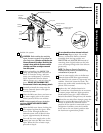
Consumer SupportTroubleshooting TipsOperating InstructionsSafety Instructions Installation Instructions
13
Filtration Drain Connection Installations
Check and comply with all state and local plumbing codes as you plan.
CAUTION: The options detailed below are the ONLY approved installation configurations. Do not use any
drain saddle device.
NOTE: Failure to follow these Installation Instructions will void the Warranty, and the Installer will be
responsible for any service, repair or damages caused thereby.
Fig. 3A.
Fig. 3B.
Fig. 3C.
From second sink
or disposer
From second sink
or disposer
From second
sink or disposer
From
faucet
air gap
Drain line from
Reverse Osmosis
by-passing faucet
air gap
Maintain air gap
at drain point in
basement
Drain line adapter
Separate p-trap
Cap (not
included)
4″
Min.
From faucet
air gap
Drain line adapter
Preferred Installation Options
(Options A, B and C)
OPTION A.
BASEMENT ACCESS INSTALLATION (Fig. 3A)
Route the drain line DIRECTLY from the Reverse Osmosis
system to a standpipe in the basement, by-passing the air
gap provided in the faucet. The drain line may also be
routed in the basement to a floor drain or washtub,
provided that the air gap in the basement is maintained.
Avoid dips, loops or low spots in the drain line. The
basement air gap and drain installation configuration
must conform to all local codes. Special air gap fittings
are available to connect the drain line to the top of the
standpipe.
OPTION B.
SEPARATE VENT INSTALLATION—
2 P-TRAP (DRY-VENTED) (Fig. 3B)
Install a separate dry-vented p-trap under the sink to
be used exclusively for the Reverse Osmosis drain line.
A dry-vented p-trap is a p-trap that has its own vent/stack.
Attach the provided drain line adapter to the p-trap and
secure it with the slip joint nut and washer as shown.
Route the drain line from the air gap to the drain line
adapter ensuring that there are no dips, loops or low
spots in the line, which could result in a clogged drain
line. The drain line adapter should be aligned vertically
such that the hose connection points in a direction 45°
off vertical. (See Fig. 3E.) The drain line must be routed
through the air gap provided in the RO water faucet.
OPTION C.
SHARED VENT INSTALLATION—
2 P-TRAP (WET-VENTED) (Fig. 3C)
Install a p-trap under the sink to be used exclusively for
the Reverse Osmosis drain line. A wet-vented p-trap is a
p-trap that shares a common vent/stack. Attach the
provided drain line adapter to the p-trap and secure it
with the slip joint nut and washer as shown. Route the
drain line from the air gap to the drain line adapter
ensuring that there are no dips, loops or low spots in the
line, which could result in a clogged drain line. The drain
line adapter should be aligned vertically such that the
hose connection points in a direction 45° off vertical.
(See Fig. 3E.) The drain line must be routed through the
air gap provided in the RO water faucet. Locate the p-trap
as high as possible (minimum of 4″ above horizontal pipe
from second sink or disposer).
Cap (not
included)


















